Hawaii is a U.S. state located in the Pacific Ocean, about 2,000 miles southwest of the mainland USA. It comprises eight main islands and numerous smaller ones, with a total land area of more than 6500 square miles. The climate here is tropical to subtropical, with temperatures ranging from 60-85F. Humidity levels are generally high throughout the year, and rainfall varies by region but tends to be heaviest during winter. Hawaii experiences frequent storms between May and November. However, these typically clear up quickly due to their location in the middle of an oceanic desert zone known as “the rain shadow.” Due to various reasons, which we will describe below, Hawaii is home to over 483 endangered species.
Anthricinan Yellow-Faced Bee
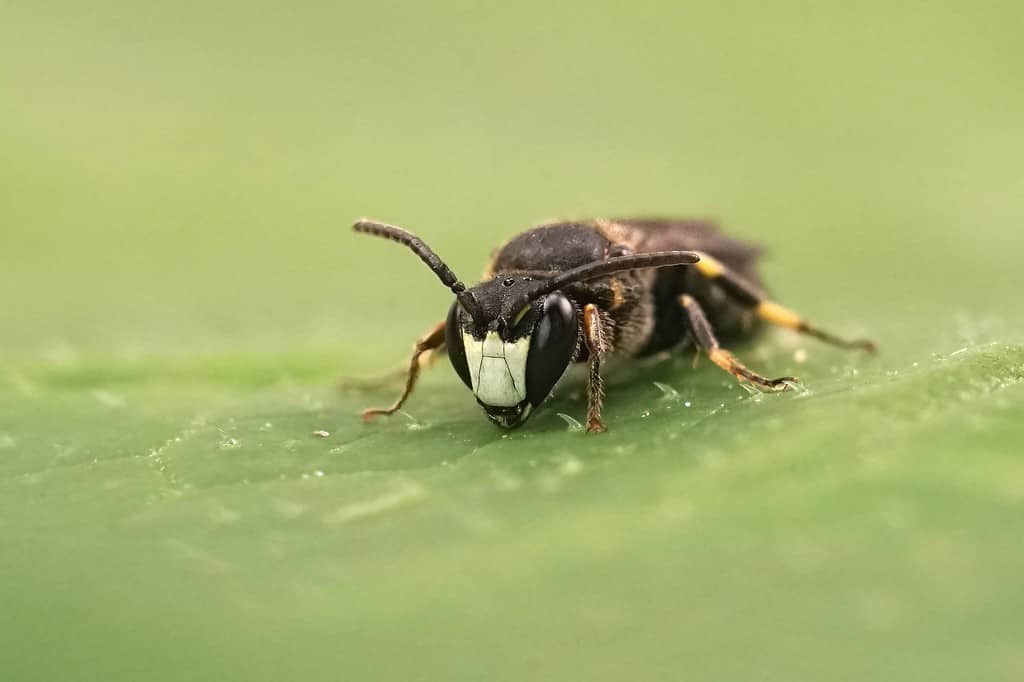
©HWall/Shutterstock.com
Hylaeus anthracinus is a medium-sized black bee that is part of the Colletidae family and subfamily Hylaeinae. The Anthricinan Yellow-Faced Bee is an endemic species native to Hawaii and is currently listed as endangered by the U.S. Fish & Wildlife Service.
The main cause of its endangerment is habitat destruction due to urban development. Deforestation and other man-made activities have also decreased the open areas where these bees can live and forage for food. Additionally, non-native invasive species of plants and animals threaten their survival. They compete with native plant populations for resources like sunlight, water, soil nutrients, and pollinators. Climate change has also played a role in their decline as rising temperatures reduce suitable habitats for them.
Finally, recreational human activities (such as biking) may disturb or disrupt nesting sites, further threatening Hawaii’s bee population.
Endangered Animals in Hawaii: Mariana Eight-Spot Butterfly
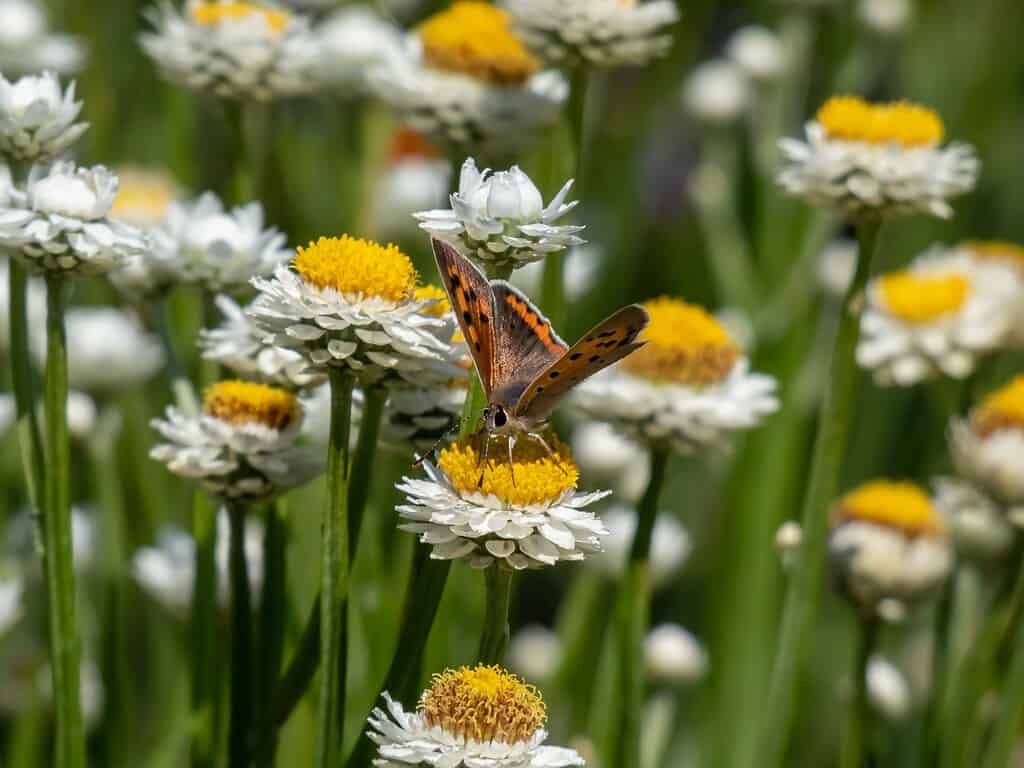
The Mariana Eight-Spot Butterfly plays an important role in the local ecosystem. It helps to pollinate other plants and animals.
©Kristine Rad/Shutterstock.com
The Mariana Eight-Spot Butterfly (Hypolimnas octocula marianensis) is a species of butterfly found throughout the islands of Hawaii. Its wings have a distinctive pattern with eight spots, hence its name. The Mariana Eight-Spot Butterfly plays an important role in the local ecosystem. It helps to pollinate other plants and animals.
Unfortunately, this species is endangered due to several factors, such as habitat destruction, pollution, and invasive species. Conservation efforts are underway to protect these butterflies’ remaining habitats. Efforts are also undertaken to increase their population numbers through reintroduction programs.
Pacific Hawaiian Damselfly
The Pacific Hawaiian Damselfly (Megalagrion pacificum) is an endemic species of damselfly found only in the main Hawaiian Islands. It is a medium-sized insect with metallic green markings on its wings and thorax. It is easily recognized by its large size compared to other local damselflies. They are important pollinators for native plants and help control populations of mosquitoes that can spread disease.
Unfortunately, Pacific Hawaiian Damselflies have been listed as endangered since 2010. This is mainly due to the loss of their habitat caused by urban development. Increased use of pesticides on agricultural lands has also impacted this specie. Their numbers have continued to decline as they need clean freshwater streams or wetlands to reproduce successfully. Conservation efforts are being put into place in order to protect these unique animals from further harm. These efforts include creating wildlife corridors that link fragmented habitats. This allows them to move safely without coming into contact with humans or their activities.
Hawaiian Picture-Wing Fly

The Hawaiian Picture-Wing Fly is one of the most important pollinators in Hawaii.
©Macronatura.es/Shutterstock.com
The Hawaiian Picture-Wing Fly is a species of insect that can be found in the Hawaiian Islands. It has distinctively patterned wings and is one of the most important pollinators in Hawaii. This fly aids in the growth of many native plants and flowers. Unfortunately, these beautiful creatures are now endangered due to human activities such as urbanization and agricultural expansion. As a result, their population numbers have declined dramatically over recent years, resulting in their endangered status today. Conservation efforts are needed to ensure that these magnificent insects remain part of our ecosystem for generations to come.
Endangered Animals in Hawaii: Laysan Duck

Laysan Ducks play an important role in the Hawaiian ecosystem as they act as scavengers that help keep their environment clean by eating algae, leaves, seeds, and invertebrates.
©Martin Fowler/Shutterstock.com
A Laysan Duck is a species of waterfowl native to Hawaii. The adult ducks are primarily brown with white speckles, curved bills, and yellow eyes. They can grow up to 17 inches in length, making them one of the largest duck species in Hawaii.
Laysan Ducks play an important role in the Hawaiian ecosystem. They act as scavengers that help keep their environment clean by eating algae, leaves, seeds, and invertebrates.
Unfortunately, these beautiful birds are endangered due to human interference. These interferences include habitat destruction caused by development and urbanization along coastal areas where they live. They are also in danger from predation from feral cats, rats, mongooses, and dogs. Pollution from tourist boats, plastic debris accumulation, and entanglement in fishing gear also cause their population to dwindle.
Conservation efforts such as captive breeding programs have been implemented. More work must be done to see this magnificent animal thriving in its natural environment.
Aga
Aga, also known as the Hawaiian Crow or ‘Alalā, is a species of birds endemic to Hawaii. It is one of two extant species in the family Corvidae that are native to Hawaii. It has been listed as critically endangered by the IUCN Red List since 1994. Aga was an important part of traditional Hawaiian culture and played a crucial role in maintaining their environment’s delicate balance. However, their population has declined drastically over the past few decades due to human activities. These activities include habitat destruction, invasive predators like rats and cats, and diseases like avian malaria caused by introduced mosquitoes. Without conservation efforts from organizations like The Nature Conservancy in Hawaii, this unique species could be lost forever.
Endangered Animals in Hawaii: Laysan Finch
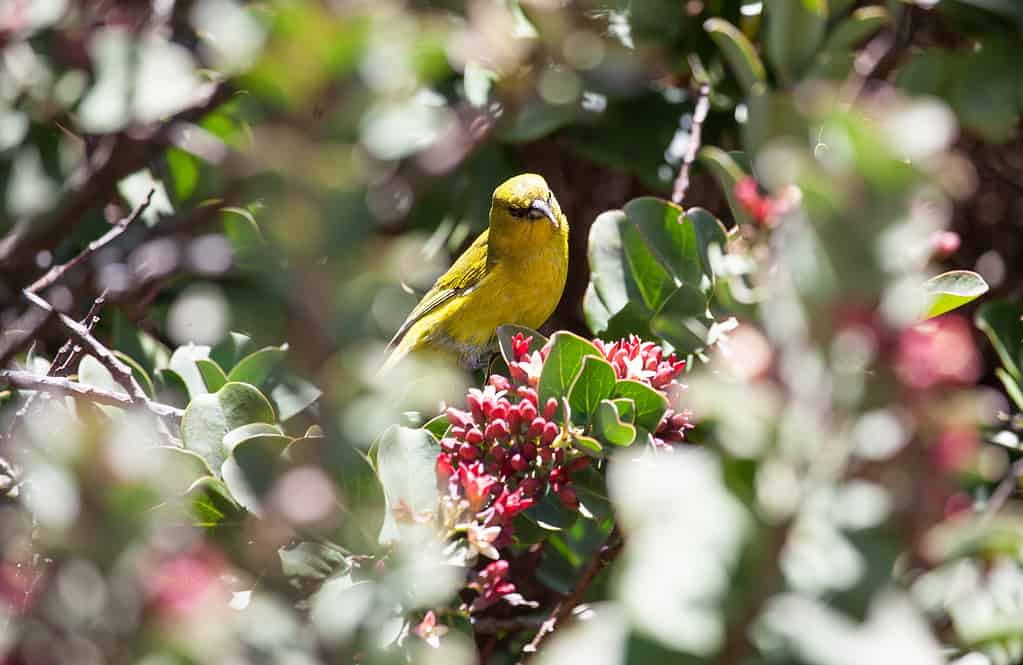
Laysan Finches are important to Hawaii’s ecosystem because they are pollinators for certain plants that are not easily dispersed by wind or other animals.
©Dai Mar Tamarack/Shutterstock.com
The Laysan Finch (Telespiza cantans) is a small species of bird native to the Hawaiian Islands. It is most commonly found in the Northwestern Hawaiian Islands. It has a yellow upper body with light gray underparts. This bird also has a distinctive dark bill that is curved downward at the tip. They primarily feed on insects and seeds found in lowland shrublands and grasslands. They also eat fruits from trees like Pandanus tectorius.
Laysan Finches are important to Hawaii’s ecosystem because they are pollinators for certain plants that are not easily dispersed by wind or other animals. They also do an excellent job of spreading plant seeds throughout their territory.
Unfortunately, Laysan Finches have become endangered due mainly to habitat loss. In addition, climate change has resulted in rising sea levels which threaten their breeding grounds on small islands around Hawaii.
Hawaiian Petrel
The Hawaiian Petrel, also known as ‘Ua’u in Hawaiian, is a medium-sized seabird native to the islands of Hawaii. It is one of only two species found exclusively within the state and is believed to have been around for thousands of years. The birds can be identified by their black upperparts with white underparts and a speckled breast band. They typically measure between 23-28 inches long from bill tip to tail tip.
Hawaiian Petrels are important members of Hawaii’s marine ecosystem as they help disperse energy and nutrients throughout the marine food chain, providing nourishment for other animals such as seals, dolphins, and sharks. They also play an important role in sustaining healthy coral reefs by transporting fish larvae between different locations.
Unfortunately, these amazing birds are endangered due to human activities such as hunting for feathers or eggs, predation from invasive mammals like cats that were imported into the island chain centuries ago, light pollution which causes confusion during migration flights at night time, habitat destruction caused by urbanization and coastal development projects along shorelines where petrels nest. With concerted conservation efforts, we can ensure that this unique species remains part of our natural heritage for generations to come!
Endangered Animals in Hawaii: Mariana Common Moorhen
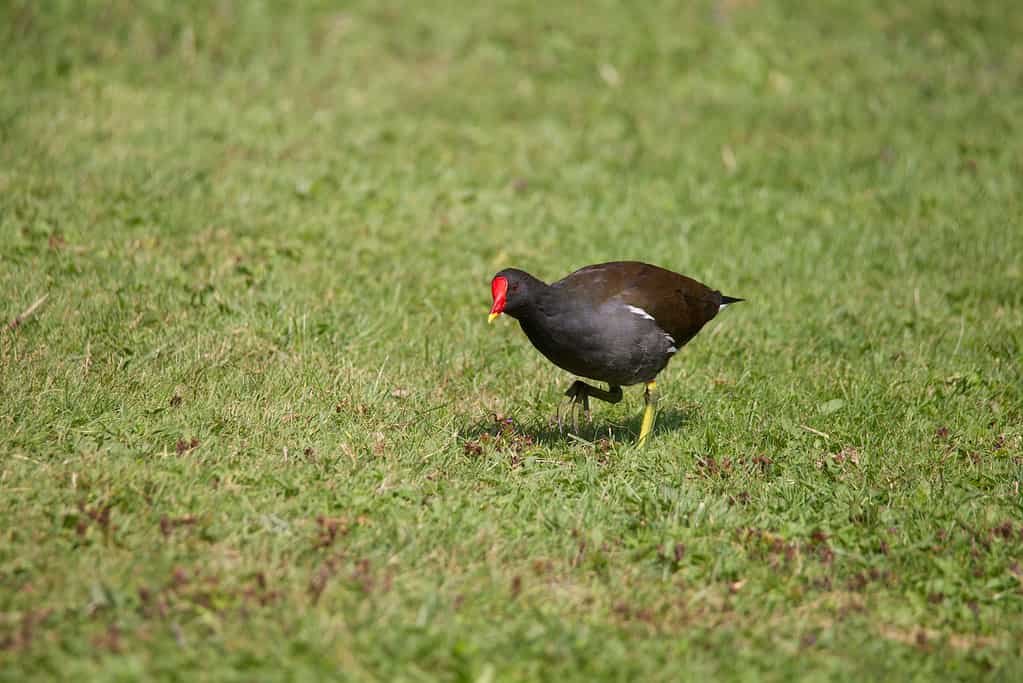
has a distinct purplish-black body, reddish-brown wings, and a red beak.
©Werner Rebel/Shutterstock.com
The Mariana Common Moorhen (Gallinula chloropus guami) is a bird species native to the Mariana Islands and Guam. It is currently listed as an endangered species in Hawaii due to its limited range and population size. This species of moorhen has a distinct purplish-black body, reddish-brown wings, and red beak. They prefer shallow wetlands but can also be seen around rivers, estuaries, ponds, and marshes.
Mariana Common Moorhens are important for the ecosystem because they provide food sources for other animals like birds of prey, snakes, lizards, and amphibians. They also help disperse aquatic plants by eating their seeds during migration periods which helps promote plant diversity in the surrounding areas. Unfortunately, their numbers have declined steadily due to habitat loss caused by human activities such as urbanization or agricultural practices. Conservation efforts are being taken in order to protect this species from further decline in Hawaii’s natural habitats.
Mariana Gray Swiftlet
The Mariana Gray Swiftlet (Aerodramus vanikorensis bartschi) is a small bird species native to the Marianas Island chain and Hawaii in the western Pacific Ocean. It has dark gray wings and upper parts, white underparts, and a long black tail with two white patches near its tip. The Mariana Gray Swiftlet lives primarily on insects captured while in flight.
These birds are important to the ecosystem because they help control insect populations that could otherwise become pests or damage crops if left unchecked. They are also an important food source for other animals, such as owls and hawks which helps maintain balance within the food web.
Unfortunately, these birds have become endangered in Hawaii due to habitat destruction caused by human activities such as logging and development. As their natural habitats disappear due to deforestation or urbanization, their numbers have drastically declined over time, leading them closer to extinction without our help. Conservation efforts must be taken now to keep this unique bird species from disappearing forever from Hawaiian skies!
Endangered Animals in Hawaii: Pacific Sheath-Tailed Bat
The Pacific sheath-tailed bat is a species of bat that is endemic to the Hawaiian islands. They are one of the smallest bats in Hawaii, with an average wingspan of only 4 inches. These small and elusive creatures play an important role in maintaining the balance of their local ecosystems by consuming large amounts of insects such as mosquitos and moths.
Unfortunately, their populations have been declining due to destruction or disturbance to their roosts, which has caused them to be listed as endangered on the IUCN Red List. Human activities such as land development, urbanization, logging, and agricultural expansion have all contributed to this decline. Conservation efforts for this species include habitat restoration projects aimed at providing safe areas for them to live and breed undisturbed.
Hawaiian Monk Seal
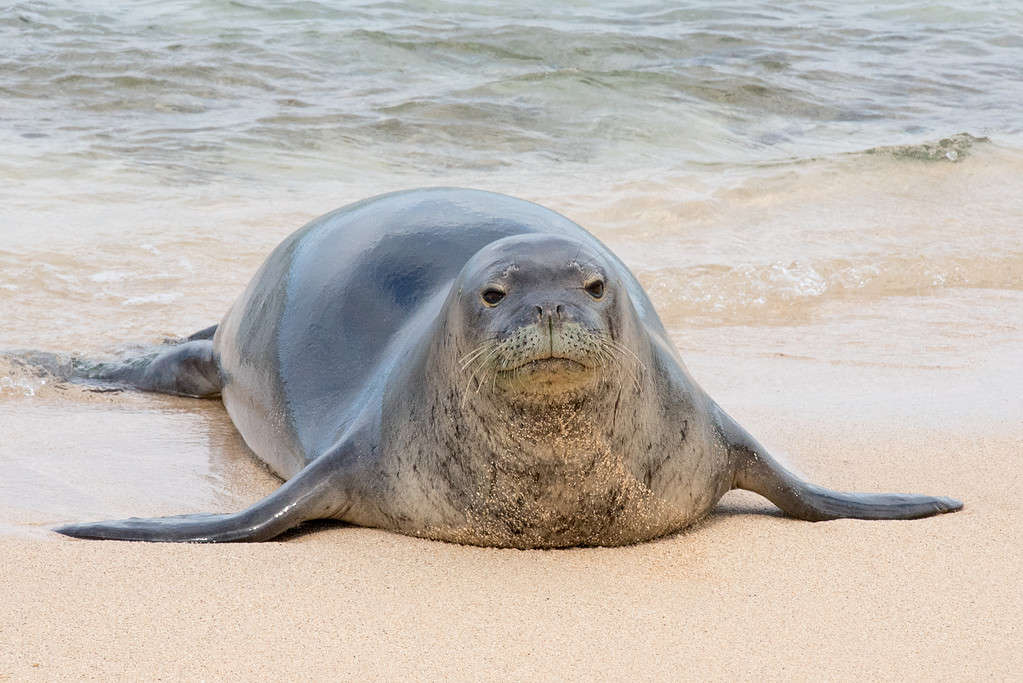
There are only 1,400 Hawaiian Monk Seals left in the world.
©Lorraine Logan/Shutterstock.com
The Hawaiian Monk Seal is a species of seal native to Hawaii and one of the most endangered animals in the U.S. They are important to the ecosystem as a predator, helping to keep populations of smaller fish, shellfish, and invertebrates balanced.
Unfortunately, these creatures are now critically endangered due to human activities such as entanglement in fishing nets, overfishing, and the destruction of their habitat from beach developments. Pollution and entanglement in marine debris also contribute to their decline. To help protect this species, conservation efforts have been put into place, such as restrictions on commercial fishing gear that can threaten seals and research into preserving habitats for them. There are only 1,400 of these seals left in the world.
Endangered Animals in Hawaii: Little Mariana Fruit Bat
The Mariana fruit bat (Pteropus m. mariannus) is a species of megabat endemic to Guam and the Commonwealth of the Northern Mariana Islands. It is one of the largest flying foxes in its range, with an average wingspan of around three feet. This species feeds mainly on fruits, blossoms, and nectar, which makes it an important pollinator for many native plants in Hawaii.
Unfortunately, it has been classified as critically endangered due to heavy predation from introduced non-native mammal predators such as cats, habitat loss due to deforestation and urbanization, hunting by humans for food or sport, and disturbance caused by recreational activities like hang gliding. As a result of these threats, their population size has declined drastically over the past few decades, leaving only about 500 individuals remaining in Hawaii today.
Leatherback Sea Turtle

The Leatherback diet consists mainly of jellyfish, making it a unique and important predator for maintaining balance within food webs.
©Stephanie Rousseau/Shutterstock.com
The Leatherback Sea Turtle (Dermochelys coriacea) is the world’s largest turtle and one of the most migratory species on earth. It can be found in tropical oceans worldwide, but its principal nesting grounds are in Hawaii. The Leatherback diet consists mainly of jellyfish, making it a unique and important predator for maintaining balance within food webs.
Unfortunately, this species is endangered due to human activities such as fishing bycatch and the destruction of coastal habitats that provide nesting areas for these turtles. Climate change has also been identified as contributing to their population decline since warmer air temperatures can cause female sea turtles to lay more eggs with male chromosomes — resulting in fewer hatchlings surviving into adulthood. Conservation efforts have been implemented in an attempt to protect Leatherback Sea Turtles from further harm. Much work remains before they will recover enough to move out of the “endangered” category.
Slevin’s Skink
Slevin’s skink is a rare species of lizard that can only be found in the Hawaiian Islands. It is an important part of the local ecosystem as it helps to keep insects and other pests under control. Unfortunately, this species has become endangered in Hawaii due to human activity, such as logging, habitat destruction, and non-native predators being introduced into the area. As they are not able to reproduce quickly enough or survive long enough to sustain their population size, conservation efforts must be employed if this species is going to have any chance at survival. Some of these include protecting their habitats from human interference and reducing the amount of land used for livestock. Along with other initiatives like captive breeding programs and reintroducing individuals back into the wild, there may still yet be hope for Slevin’s skink populations in Hawaii to survive for future generations.
Endangered Animals in Hawaii: What Can Humans Do to Help?
Habitat loss is a major factor in the endangerment of the animals of Hawaii. One main contributor to this habitat loss is grazing livestock and the hay and grains that are grown to feed livestock. Coffee fields also take up a lot of the natural land of Hawaii.
Reducing our consumption of beef, pork, dairy, and coffee could help protect the wild animals in Hawaii since much of their habitat is used for grazing livestock and growing coffee. Not only would this help to reduce the amount of land needed for such practices, but it would also give more space back to nature, which could benefit endangered species trying to survive in shrinking habitats.
Other measures humans can take include engaging in conservation efforts like planting native plants and trees or creating protective areas so wildlife can flourish without human interference. Additionally, individuals should ensure not to buy products made from endangered animal parts like ivory or shark fins, which will contribute directly to their decline. Finally, we should spread awareness about these creatures’ plight and encourage others around us to join forces with us to help them survive!
The photo featured at the top of this post is © Martin Fowler/Shutterstock.com
Thank you for reading! Have some feedback for us? Contact the AZ Animals editorial team.






